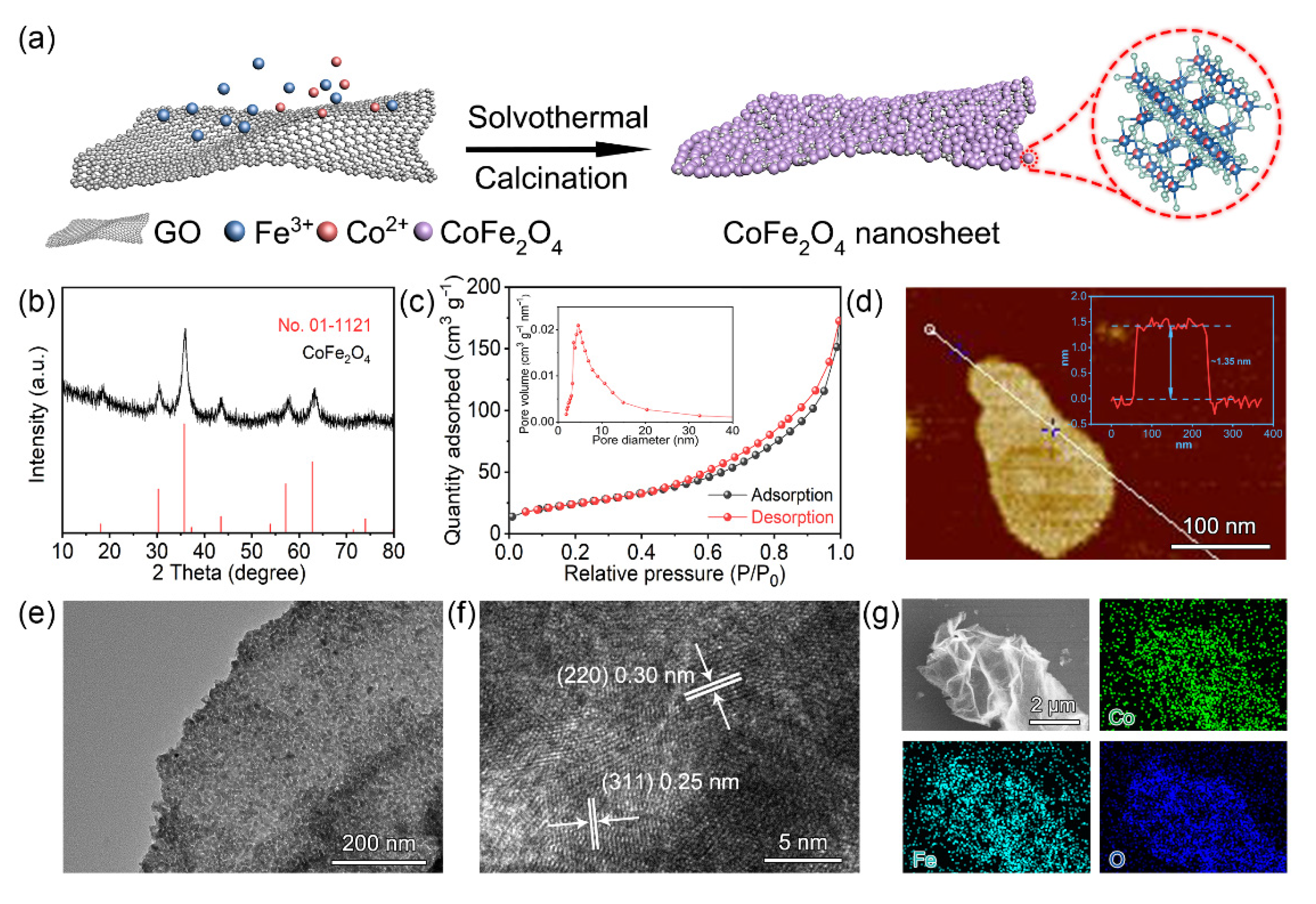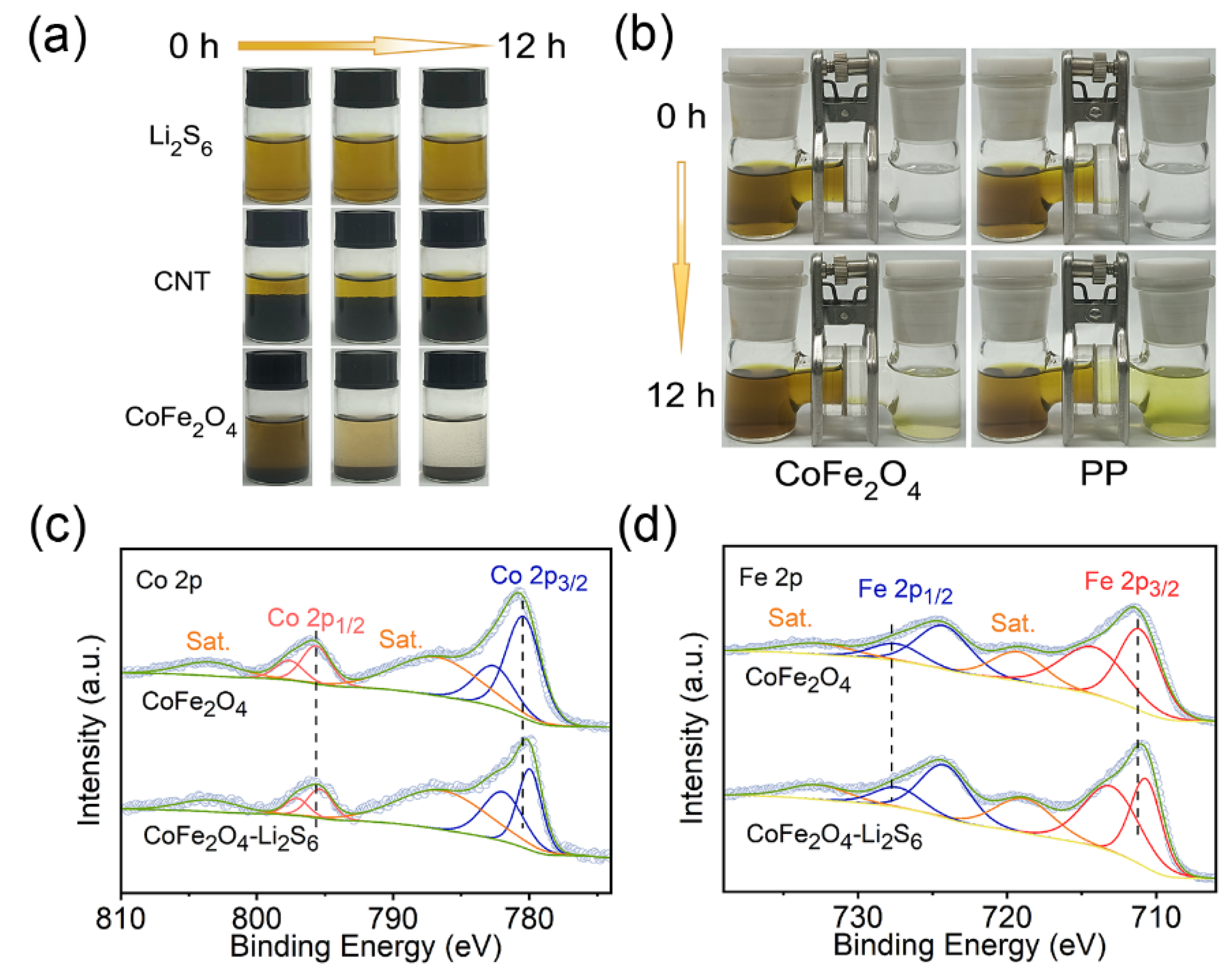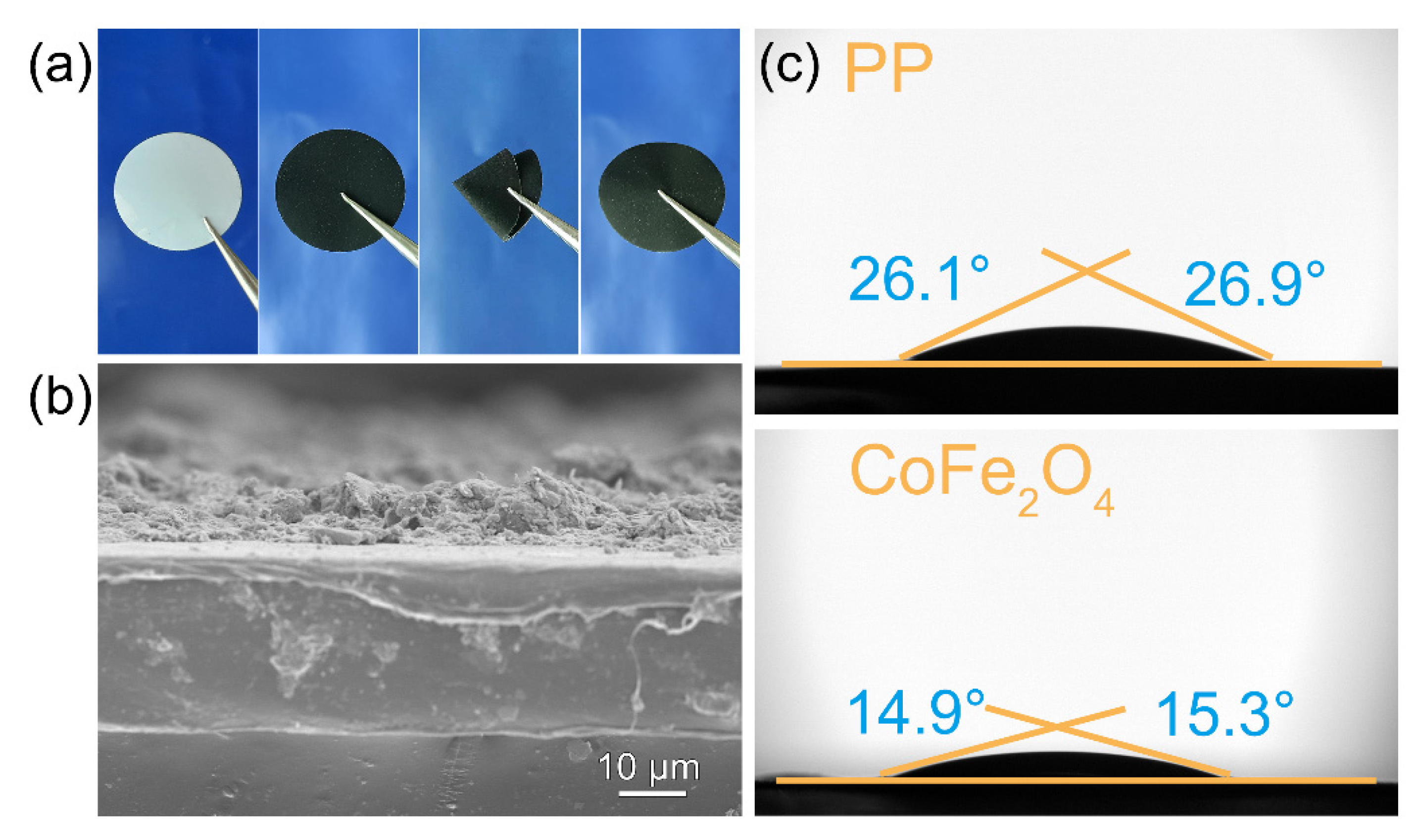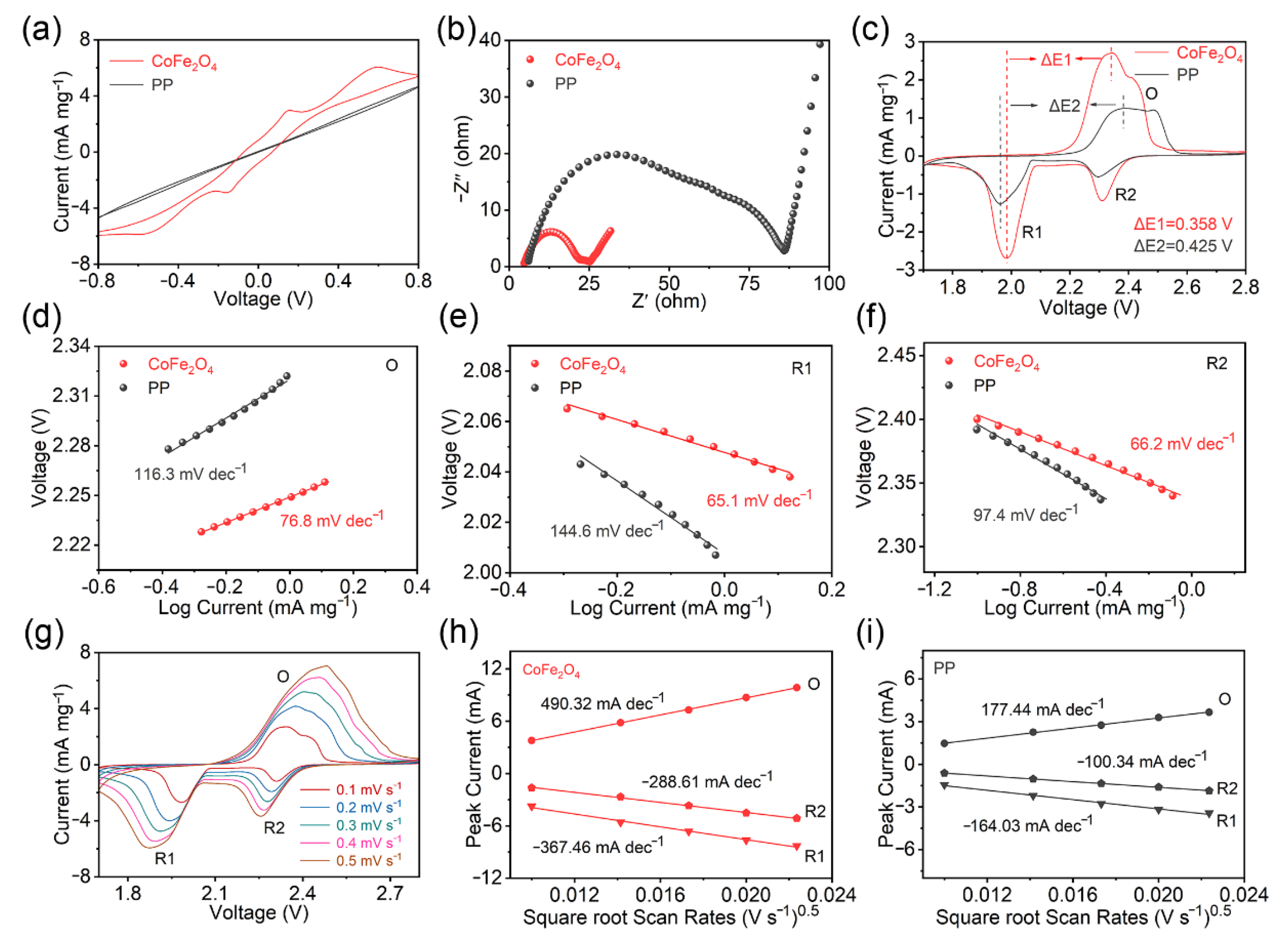Ultrathin Two-Dimensional Fe–Co Bimetallic Oxide Nanosheets for Separator Modification of Lithium–Sulfur Batteries
Abstract
1. Introduction
2. Results and Discussion
3. Materials and Methods
3.1. Preparation of CoFe2O4 and Modified Separator
3.2. Materials Characterization
3.3. Visualization Lithium Polysulfide Adsorption
3.4. Battery Assembly and Electrochemical Measurements
4. Conclusions
Supplementary Materials
Author Contributions
Funding
Institutional Review Board Statement
Informed Consent Statement
Data Availability Statement
Acknowledgments
Conflicts of Interest
Sample Availability
References
- Zubi, G.; Dufo-López, R.; Carvalho, M.; Pasaoglu, G. The lithium-ion battery: State of the art and future perspectives. Renew. Sust. Energ. Rev. 2018, 89, 292–308. [Google Scholar] [CrossRef]
- Li, H.; Wang, H.; Xu, Z.; Wang, K.; Ge, M.; Gan, L.; Zhang, Y.; Tang, Y.; Chen, S. Thermal-Responsive and Fire-Resistant Materials for High-Safety Lithium-Ion Batteries. Small 2021, 17, 2103679. [Google Scholar] [CrossRef] [PubMed]
- Zhao, H.; Deng, N.; Yan, J.; Kang, W.; Ju, J.; Ruan, Y.; Wang, X.; Zhuang, X.; Li, Q.; Cheng, B. A review on anode for lithium-sulfur batteries: Progress and prospects. Chem. Eng. J. 2018, 347, 343–365. [Google Scholar] [CrossRef]
- Xiao, D.; Lu, C.; Chen, C.; Yuan, S. CeO2-webbed carbon nanotubes as a highly efficient sulfur host for lithium-sulfur batteries. Energy Storage Mater. 2018, 10, 216–222. [Google Scholar] [CrossRef]
- Ding, B.; Wang, J.; Fan, Z.; Chen, S.; Lin, Q.; Lu, X.; Dou, H.; Kumar Nanjundan, A.; Yushin, G.; Zhang, X.; et al. Solid-state lithium–sulfur batteries: Advances, challenges and perspectives. Mater. Today 2020, 40, 114–131. [Google Scholar] [CrossRef]
- Huang, Y.C.; Yen, Y.J.; Tseng, Y.H.; Chung, S.H. Module-Designed Carbon-Coated Separators for High-Loading, High-Sulfur-Utilization Cathodes in Lithium-Sulfur Batteries. Molecules 2021, 27, 288. [Google Scholar] [CrossRef]
- Li, C.; Liu, R.; Xiao, Y.; Cao, F.; Zhang, H. Recent progress of separators in lithium-sulfur batteries. Energy Storage Mater. 2021, 40, 439–460. [Google Scholar] [CrossRef]
- Deng, N.; Wang, Y.; Yan, J.; Ju, J.; Li, Z.; Fan, L.; Zhao, H.; Kang, W.; Cheng, B. A F-doped tree-like nanofiber structural poly-m-phenyleneisophthalamide separator for high-performance lithium-sulfur batteries. J. Power Sources 2017, 362, 243–249. [Google Scholar] [CrossRef]
- Zhu, P.; Zang, J.; Zhu, J.; Lu, Y.; Chen, C.; Jiang, M.; Yan, C.; Dirican, M.; Selvan, R.K.; Kim, D.; et al. Effect of reduced graphene oxide reduction degree on the performance of polysulfide rejection in lithium-sulfur batteries. Carbon 2018, 126, 594–600. [Google Scholar] [CrossRef]
- Zhang, J.; Cheng, Y.; Chen, H.; Wang, Y.; Chen, Q.; Hou, G.; Wen, M.; Tang, Y. MoP Quantum Dot-Modified N,P-Carbon Nanotubes as a Multifunctional Separator Coating for High-Performance Lithium-Sulfur Batteries. ACS Appl. Mater. Interfaces 2022, 14, 16289–16299. [Google Scholar] [CrossRef]
- Wang, X.; Liu, H.; Wang, Q.; Zhang, G.; Pei, C.; Wang, H.; Guo, S. In-situ fabrication of dense structure nitrogen-doped carbon nanotube embedded Co/Co2P accelerating the electrochemical kinetics of lithium-sulfur battery. Appl. Sur. Sci. 2022, 595, 153488. [Google Scholar] [CrossRef]
- Zhang, Y.; Hu, M.; Yuan, M.; Sun, G.; Li, Y.; Zhou, K.; Chen, C.; Nan, C.; Li, Y. Ordered two-dimensional porous Co3O4 nanosheets as electrocatalysts for rechargeable Li-O2 batteries. Nano Res. 2018, 12, 299–302. [Google Scholar] [CrossRef]
- Hu, N.; Lv, X.; Dai, Y.; Fan, L.; Xiong, D.; Li, X. SnO2/Reduced Graphene Oxide Interlayer Mitigating the Shuttle Effect of Li-S Batteries. ACS Appl. Mater. Interfaces 2018, 10, 18665–18674. [Google Scholar] [CrossRef] [PubMed]
- Lee, S.K.; Kim, H.; Bang, S.; Myung, S.T.; Sun, Y.K. WO3 Nanowire/Carbon Nanotube Interlayer as a Chemical Adsorption Mediator for High-Performance Lithium-Sulfur Batteries. Molecules 2021, 26, 377. [Google Scholar] [CrossRef] [PubMed]
- Wang, X.; Yang, L.; Wang, Y.; Li, Q.; Chen, C.; Zhong, B.; Chen, Y.; Guo, X.; Wu, Z.; Liu, Y.; et al. Novel functional separator with self-assembled MnO2 layer via a simple and fast method in lithium-sulfur battery. J. Colloid Interf. Sci. 2022, 606, 666–676. [Google Scholar] [CrossRef]
- Zhang, J.; Rao, Q.; Jin, B.; Lu, J.; He, Q.-g.; Hou, Y.; Li, Z.; Zhan, X.; Chen, F.; Zhang, Q. Cerium oxide embedded bilayer separator enabling fast polysulfide conversion for high-performance lithium-sulfur batteries. Chem. Eng. J. 2020, 388, 124120. [Google Scholar] [CrossRef]
- Pu, J.; Liu, Z.; Ma, Z.; Wang, J.; Zhang, L.; Chang, S.; Wu, W.; Shen, Z.; Zhang, H. Structure design of NiCo2O4 electrodes for high performance pseudocapacitors and lithium-ion batteries. J. Mater. Chem. A 2016, 4, 17394–17402. [Google Scholar] [CrossRef]
- Shen, L.; Yu, L.; Yu, X.Y.; Zhang, X.; Lou, X.W. Self-templated formation of uniform NiCo2O4 hollow spheres with complex interior structures for lithium-ion batteries and supercapacitors. Angew. Chem. Int. Ed. 2015, 54, 1868–1872. [Google Scholar] [CrossRef] [PubMed]
- Guo, Y.; Liu, X.; Li, Y.; Ma, F.; Zhang, Q.; Wang, Z.; Liu, Y.; Zheng, Z.; Cheng, H.; Huang, B.; et al. Anion-modulation in CoMoO4 electrocatalyst for urea-assisted energy-saving hydrogen production. Int. J. Hydrogen Energy 2022, 47, 33167–33176. [Google Scholar] [CrossRef]
- Zhu, Y.; Zuo, Y.; Ye, F.; Zhou, J.; Tang, Y.; Chen, Y. Dual-regulation strategy to enhance electrochemical catalysis ability of NiCo2O4-x for polysulfides conversion in Li-S batteries. Chem. Eng. J. 2022, 428, 131109. [Google Scholar] [CrossRef]
- Lv, X.; Lei, T.; Wang, B.; Chen, W.; Jiao, Y.; Hu, Y.; Yan, Y.; Huang, J.; Chu, J.; Yan, C.; et al. An Efficient Separator with Low Li-Ion Diffusion Energy Barrier Resolving Feeble Conductivity for Practical Lithium–Sulfur Batteries. Adv. Energy Mater. 2019, 9, 1901800. [Google Scholar] [CrossRef]
- Shao, Q.; Xu, L.; Guo, D.; Su, Y.; Chen, J. Atomic level design of single iron atom embedded mesoporous hollow carbon spheres as multi-effect nanoreactors for advanced lithium–sulfur batteries. J. Mater. Chem. A 2020, 8, 23772–23783. [Google Scholar] [CrossRef]
- Bhargav, A.; He, J.; Gupta, A.; Manthiram, A. Lithium-Sulfur Batteries: Attaining the Critical Metrics. Joule 2020, 4, 285–291. [Google Scholar] [CrossRef]
- Li, H.; Shi, Y.; Chiu, M.-H.; Li, L.-J. Emerging energy applications of two-dimensional layered transition metal dichalcogenides. Nano Energy 2015, 18, 293–305. [Google Scholar] [CrossRef]
- Mu, T.; Zuo, P.; Lou, S.; Pan, Q.; Li, Q.; Du, C.; Gao, Y.; Cheng, X.; Ma, Y.; Yin, G. A two-dimensional nitrogen-rich carbon/silicon composite as high performance anode material for lithium ion batteries. Chem. Eng. J. 2018, 341, 37–46. [Google Scholar] [CrossRef]
- Jiang, Y.; Liang, P.; Tang, M.; Sun, S.; Min, H.; Han, J.; Shen, X.; Yang, H.; Chao, D.; Wang, J. A high-throughput screening permeability separator with high catalytic conversion kinetics for Li–S batteries. J. Mater. Chem. A 2022, 10, 22080–22092. [Google Scholar] [CrossRef]
- Dong, W.; Meng, L.; Hong, X.; Liu, S.; Shen, D.; Xia, Y.; Yang, S. MnO2/rGO/CNTs Framework as a Sulfur Host for High-Performance Li-S Batteries. Molecules 2020, 25, 1989. [Google Scholar] [CrossRef]
- Haridas, A.K.; Angulakshmi, N.; Stephan, A.M.; Lee, Y.; Ahn, J.H. A Hierarchically Ordered Mesoporous-Carbon-Supported Iron Sulfide Anode for High-Rate Na-Ion Storage. Molecules 2021, 26, 4349. [Google Scholar] [CrossRef]
- Wei, X.; Lin, C.C.; Wu, C.; Qaiser, N.; Cai, Y.; Lu, A.Y.; Qi, K.; Fu, J.H.; Chiang, Y.H.; Yang, Z.; et al. Three-dimensional hierarchically porous MoS2 foam as high-rate and stable lithium-ion battery anode. Nat. Commun. 2022, 13, 6006. [Google Scholar] [CrossRef]
- AbdelHamid, A.A.; Yu, Y.; Yang, J.; Ying, J.Y. Generalized Synthesis of Metal Oxide Nanosheets and Their Application as Li-Ion Battery Anodes. Adv. Mater. 2017, 29, 1701427. [Google Scholar] [CrossRef]
- Peng, L.; Xiong, P.; Ma, L.; Yuan, Y.; Zhu, Y.; Chen, D.; Luo, X.; Lu, J.; Amine, K.; Yu, G. Holey two-dimensional transition metal oxide nanosheets for efficient energy storage. Nat. Commun. 2017, 8, 15139. [Google Scholar] [CrossRef] [PubMed]
- Zhang, X.; Bruck, A.M.; Zhu, Y.; Peng, L.; Li, J.; Stach, E.; Zhu, Y.; Takeuchi, K.J.; Takeuchi, E.S.; Marschilok, A.C.; et al. Probing enhanced lithium-ion transport kinetics in 2D holey nanoarchitectured electrodes. Nano Futures 2018, 2, 035008. [Google Scholar] [CrossRef]
- Pang, Q.; Kundu, D.; Nazar, L.F. A graphene-like metallic cathode host for long-life and high-loading lithium–sulfur batteries. Mater. Horiz. 2016, 3, 130–136. [Google Scholar] [CrossRef]
- Zhang, Q.; Wang, Y.; Seh, Z.W.; Fu, Z.; Zhang, R.; Cui, Y. Understanding the Anchoring Effect of Two-Dimensional Layered Materials for Lithium-Sulfur Batteries. Nano Lett. 2015, 15, 3780–3786. [Google Scholar] [CrossRef]
- Wang, Y.; Zhu, L.; Wang, J.; Zhang, Z.; Yu, J.; Yang, Z. Enhanced chemisorption and catalytic conversion of polysulfides via CoFe@NC nanocubes modified separator for superior Li–S batteries. Chem. Eng. J. 2022, 433, 133792. [Google Scholar] [CrossRef]
- Li, M.; Wang, H.; Wang, X.; Ren, J.; Wang, R. Metallic FeCo clusters propelling the stepwise polysulfide conversion in lithium–sulfur batteries. J. Mater. Chem. A 2022, 10, 21327–21335. [Google Scholar] [CrossRef]
- Deng, D.R.; Xue, F.; Jia, Y.J.; Ye, J.C.; Bai, C.D.; Zheng, M.S.; Dong, Q.F. Co4N Nanosheet Assembled Mesoporous Sphere as a Matrix for Ultrahigh Sulfur Content Lithium-Sulfur Batteries. ACS Nano 2017, 11, 6031–6039. [Google Scholar] [CrossRef]
- Zhong, Y.; Yin, L.; He, P.; Liu, W.; Wu, Z.; Wang, H. Surface Chemistry in Cobalt Phosphide-Stabilized Lithium-Sulfur Batteries. J. Am. Chem. Soc. 2018, 140, 1455–1459. [Google Scholar] [CrossRef]
- Li, D.; Baydoun, H.; Verani, C.N.; Brock, S.L. Efficient Water Oxidation Using CoMnP Nanoparticles. J. Am. Chem. Soc. 2016, 138, 4006–4009. [Google Scholar] [CrossRef]
- Roy, S.B.; Truong, L.; Jeon, J.H.; Lee, S.; Jerng, S.-K.; Jung, E.; Chan Jun, S.; Chun, S.-H. Highly Desirable Platform for Efficient Hydrogen Generation: Electrodeposited CoP on N-Doped Vertical Graphene. ACS Appl. Energy Mater. 2021, 4, 5697–5705. [Google Scholar] [CrossRef]
- Qiao, Z.; Zhang, Y.; Meng, Z.; Xie, Q.; Lin, L.; Zheng, H.; Sa, B.; Lin, J.; Wang, L.; Peng, D.L. Anchoring Polysulfides and Accelerating Redox Reaction Enabled by Fe-Based Compounds in Lithium–Sulfur Batteries. Adv. Funct. Mater. 2021, 31, 2011970. [Google Scholar] [CrossRef]
- Han, X.; Ge, J.; Luo, J.; Wang, Y.; Zhao, X.; Zhang, F.; Lei, X. Construction of vacancies-enriched CuS/Fe2O3 with nano-heterojunctions as negative electrode for flexible solid-state supercapacitor. J. Alloy. Compound. 2022, 916, 165443. [Google Scholar] [CrossRef]
- Balach, J.; Singh, H.K.; Gomoll, S.; Jaumann, T.; Klose, M.; Oswald, S.; Richter, M.; Eckert, J.; Giebeler, L. Synergistically Enhanced Polysulfide Chemisorption Using a Flexible Hybrid Separator with N and S Dual-Doped Mesoporous Carbon Coating for Advanced Lithium-Sulfur Batteries. ACS Appl. Mater. Interfaces 2016, 8, 14586–14595. [Google Scholar] [CrossRef] [PubMed]
- Zeng, G.; Liu, Y.; Chen, D.; Zhen, C.; Han, Y.; He, W. Natural Lepidolite Enables Fast Polysulfide Redox for High-Rate Lithium Sulfur Batteries. Adv. Energy Mater. 2021, 11, 2102058. [Google Scholar] [CrossRef]
- Pu, J.; Wu, J.; Tan, Y.; Yu, S. Cobalt nitride nanocrystals coated separator as multifunctional interlayer for improving polysulfides regulation. J. Alloy. Compound. 2022, 920, 165964. [Google Scholar] [CrossRef]
- Wei, Z.; Zhang, N.; Feng, T.; Wu, F.; Zhao, T.; Chen, R. A copolymer microspheres-coated separator to enhance thermal stability of lithium-sulfur batteries. Chem. Eng. J. 2022, 430, 132678. [Google Scholar] [CrossRef]
- Zhu, W.; Zhang, Z.; Wei, J.; Jing, Y.; Guo, W.; Xie, Z.; Qu, D.; Liu, D.; Tang, H.; Li, J. A synergistic modification of polypropylene separator toward stable lithium-sulfur battery. J. Membrane Sci. 2020, 597, 117646. [Google Scholar] [CrossRef]
- Pu, J.; Wang, T.; Zhu, X.; Tan, Y.; Gao, L.; Chen, J.; Huang, J.; Wang, Z. Multifunctional Ni/NiO heterostructure nanoparticles doped carbon nanorods modified separator for enhancing Li-S battery performance. Electrochim. Acta 2022, 435, 141396. [Google Scholar] [CrossRef]
- Zhan, L.; Zhou, X.; Luo, J.; Fan, X.; Ning, X. Urchin-like Nb2O5/CNT modified separator for lithium-sulfur batteries. Int. J. Hydrogen Energy 2022, 47, 27671–27679. [Google Scholar] [CrossRef]
- Li, P.; Deng, J.; Li, J.; Wang, L.; Guo, J. Hollow graphene spheres coated separator as an efficient trap for soluble polysulfides in Li-S battery. Ceram. Int. 2019, 45, 13219–13224. [Google Scholar] [CrossRef]
- Ji, M.; Ni, J.; Liang, X.; Cheng, Q.; Gao, G.; Wu, G.; Xiao, Q. Biomimetic Synthesis of VOx@C Yolk-Shell Nanospheres and Their Application in Li-S Batteries. Adv. Funct. Mater. 2022, 2206589. [Google Scholar] [CrossRef]
- Yeon, J.S.; Ko, Y.H.; Park, T.H.; Park, H.; Kim, J.; Park, H.S. Multidimensional Hybrid Architecture Encapsulating Cobalt Oxide Nanoparticles into Carbon Nanotube Branched Nitrogen-Doped Reduced Graphene Oxide Networks for Lithium–Sulfur Batteries. Energy Environ. Mater. 2021, 5, 555–564. [Google Scholar] [CrossRef]
- Guo, Y.; Wu, P.; Zhong, H.; Huang, J.; Ma, G.; Xu, Z.; Wu, Y.; Zeb, A.; Lin, X. Prussian blue analogue/KB-derived Ni/Co/KB composite as a superior adsorption-catalysis separator modification material for Li-S batteries. J. Colloid Interf. Sci. 2022, 625, 425–434. [Google Scholar] [CrossRef] [PubMed]
- Pu, J.; Wang, Z.; Xue, P.; Zhu, K.; Li, J.; Yao, Y. The effect of NiO-Ni3N interfaces in in-situ formed heterostructure ultrafine nanoparticles on enhanced polysulfide regulation in lithium-sulfur batteries. J. Energy Chem. 2022, 68, 762–770. [Google Scholar] [CrossRef]





Publisher’s Note: MDPI stays neutral with regard to jurisdictional claims in published maps and institutional affiliations. |
© 2022 by the authors. Licensee MDPI, Basel, Switzerland. This article is an open access article distributed under the terms and conditions of the Creative Commons Attribution (CC BY) license (https://creativecommons.org/licenses/by/4.0/).
Share and Cite
Pu, J.; Tan, Y.; Wang, T.; Zhu, X.; Fan, S. Ultrathin Two-Dimensional Fe–Co Bimetallic Oxide Nanosheets for Separator Modification of Lithium–Sulfur Batteries. Molecules 2022, 27, 7762. https://doi.org/10.3390/molecules27227762
Pu J, Tan Y, Wang T, Zhu X, Fan S. Ultrathin Two-Dimensional Fe–Co Bimetallic Oxide Nanosheets for Separator Modification of Lithium–Sulfur Batteries. Molecules. 2022; 27(22):7762. https://doi.org/10.3390/molecules27227762
Chicago/Turabian StylePu, Jun, Yun Tan, Tao Wang, Xiaomei Zhu, and Shanshan Fan. 2022. "Ultrathin Two-Dimensional Fe–Co Bimetallic Oxide Nanosheets for Separator Modification of Lithium–Sulfur Batteries" Molecules 27, no. 22: 7762. https://doi.org/10.3390/molecules27227762
APA StylePu, J., Tan, Y., Wang, T., Zhu, X., & Fan, S. (2022). Ultrathin Two-Dimensional Fe–Co Bimetallic Oxide Nanosheets for Separator Modification of Lithium–Sulfur Batteries. Molecules, 27(22), 7762. https://doi.org/10.3390/molecules27227762







